Akt and mTORC1 have different roles during liver tumorigenesis in mice
- PMID: 23376645
- PMCID: PMC3633657
- DOI: 10.1053/j.gastro.2013.01.053
Akt and mTORC1 have different roles during liver tumorigenesis in mice
Abstract
Background & aims: Phosphatidylinositide 3-kinase (PI3K) is deregulated in many human tumor types, including primary liver malignancies. The kinase v-akt murine thymoma viral oncogene homolog 1 (Akt) and mammalian target of rapamycin complex (mTORC1) are effectors of PI3K that promote cell growth and survival, but their individual roles in tumorigenesis are not well defined.
Methods: In livers of albumin (Alb)-Cre mice, we selectively deleted tuberous sclerosis (Tsc)1, a negative regulator of Ras homolog enriched in brain and mTORC1, along with Phosphatase and tensin homolog (Pten), a negative regulator of PI3K. Tumor tissues were characterized by histologic and biochemical analyses.
Results: The Tsc1fl/fl;AlbCre, Ptenfl/fl;AlbCre, and Tsc1fl/fl;Ptenfl/fl;AlbCre mice developed liver tumors that differed in size, number, and histologic features. Livers of Tsc1fl/fl;AlbCre mice did not develop steatosis; tumors arose later than in the other strains of mice and were predominantly hepatocellular carcinomas. Livers of the Ptenfl/fl;AlbCre mice developed steatosis and most of the tumors that formed were intrahepatic cholangiocarcinomas. Livers of Tsc1fl/fl;Ptenfl/fl;AlbCre formed large numbers of tumors, of mixed histologies, with the earliest onset of any strain, indicating that loss of Tsc1 and Pten have synergistic effects on tumorigenesis. In these mice, the combination of rapamycin and MK2206 was more effective in reducing liver cell proliferation and inducing cell death than either reagent alone. Tumor differentiation correlated with Akt and mTORC1 activities; the ratio of Akt:mTORC1 activity was high throughout the course of intrahepatic cholangiocarcinomas development and low during hepatocellular carcinoma development. Compared with surrounding nontumor liver tissue, tumors from all 3 strains had increased activities of Akt, mTORC1, and mitogen-activated protein kinase and overexpressed fibroblast growth factor receptor 1. Inhibition of fibroblast growth factor receptor 1 in Tsc1-null mice suppressed Akt and mitogen-activated protein kinase activities in tumor cells.
Conclusions: Based on analyses of knockout mice, mTORC1 and Akt have different yet synergistic effects during the development of liver tumors in mice.
Copyright © 2013 AGA Institute. Published by Elsevier Inc. All rights reserved.
Figures
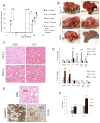
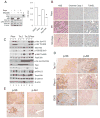
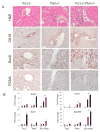
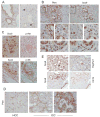
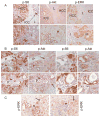
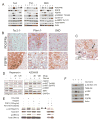
Similar articles
-
TSC/mTORC1 mediates mTORC2/AKT1 signaling in c-MYC-induced murine hepatocarcinogenesis via centromere protein M.J Clin Invest. 2024 Sep 26;134(22):e174415. doi: 10.1172/JCI174415. J Clin Invest. 2024. PMID: 39325536 Free PMC article.
-
4EBP1/eIF4E and p70S6K/RPS6 axes play critical and distinct roles in hepatocarcinogenesis driven by AKT and N-Ras proto-oncogenes in mice.Hepatology. 2015 Jan;61(1):200-13. doi: 10.1002/hep.27396. Epub 2014 Nov 25. Hepatology. 2015. PMID: 25145583 Free PMC article.
-
Increased lipogenesis, induced by AKT-mTORC1-RPS6 signaling, promotes development of human hepatocellular carcinoma.Gastroenterology. 2011 Mar;140(3):1071-83. doi: 10.1053/j.gastro.2010.12.006. Epub 2010 Dec 11. Gastroenterology. 2011. PMID: 21147110 Free PMC article.
-
[Molecular and metabolic changes in human clear cell liver foci].Pathologe. 2015 Nov;36 Suppl 2:210-5. doi: 10.1007/s00292-015-0089-9. Pathologe. 2015. PMID: 26483250 Review. German.
-
Dissecting the signaling pathways that mediate cancer in PTEN and LKB1 double-knockout mice.Sci Signal. 2015 Sep 1;8(392):pe1. doi: 10.1126/scisignal.aac8321. Sci Signal. 2015. PMID: 26329580 Review.
Cited by
-
Pathological Consequences of Hepatic mTORC1 Dysregulation.Genes (Basel). 2020 Aug 5;11(8):896. doi: 10.3390/genes11080896. Genes (Basel). 2020. PMID: 32764389 Free PMC article. Review.
-
TSC1/2 mutations-a unique type of mutation suitable for liver transplantation of Hepatocellular carcinoma.J Gastrointest Oncol. 2021 Jun;12(3):1074-1085. doi: 10.21037/jgo-20-378. J Gastrointest Oncol. 2021. PMID: 34295558 Free PMC article.
-
Autophagy and liver cancer.Clin Mol Hepatol. 2020 Oct;26(4):606-617. doi: 10.3350/cmh.2020.0169. Epub 2020 Oct 1. Clin Mol Hepatol. 2020. PMID: 33053934 Free PMC article. Review.
-
Role of mechanistic target of rapamycin in autophagy and alcohol-associated liver disease.Am J Physiol Cell Physiol. 2022 Oct 1;323(4):C1100-C1111. doi: 10.1152/ajpcell.00281.2022. Epub 2022 Sep 5. Am J Physiol Cell Physiol. 2022. PMID: 36062877 Free PMC article. Review.
-
mTORC1 and FGFR1 signaling in fibrolamellar hepatocellular carcinoma.Mod Pathol. 2015 Jan;28(1):103-10. doi: 10.1038/modpathol.2014.78. Epub 2014 Jun 13. Mod Pathol. 2015. PMID: 24925055
References
-
- Zucman-Rossi J. Molecular classification of hepatocellular carcinoma. Dig Liver Dis. 2010 Jul;42(Suppl 3):S235–241. - PubMed
Publication types
MeSH terms
Substances
Grants and funding
LinkOut - more resources
Full Text Sources
Other Literature Sources
Molecular Biology Databases
Research Materials
Miscellaneous

